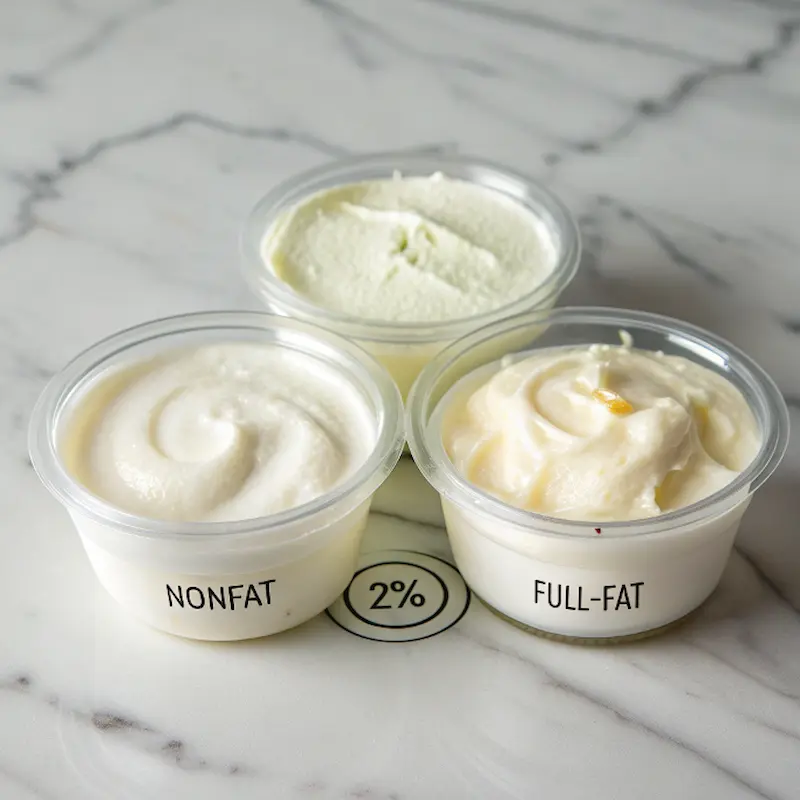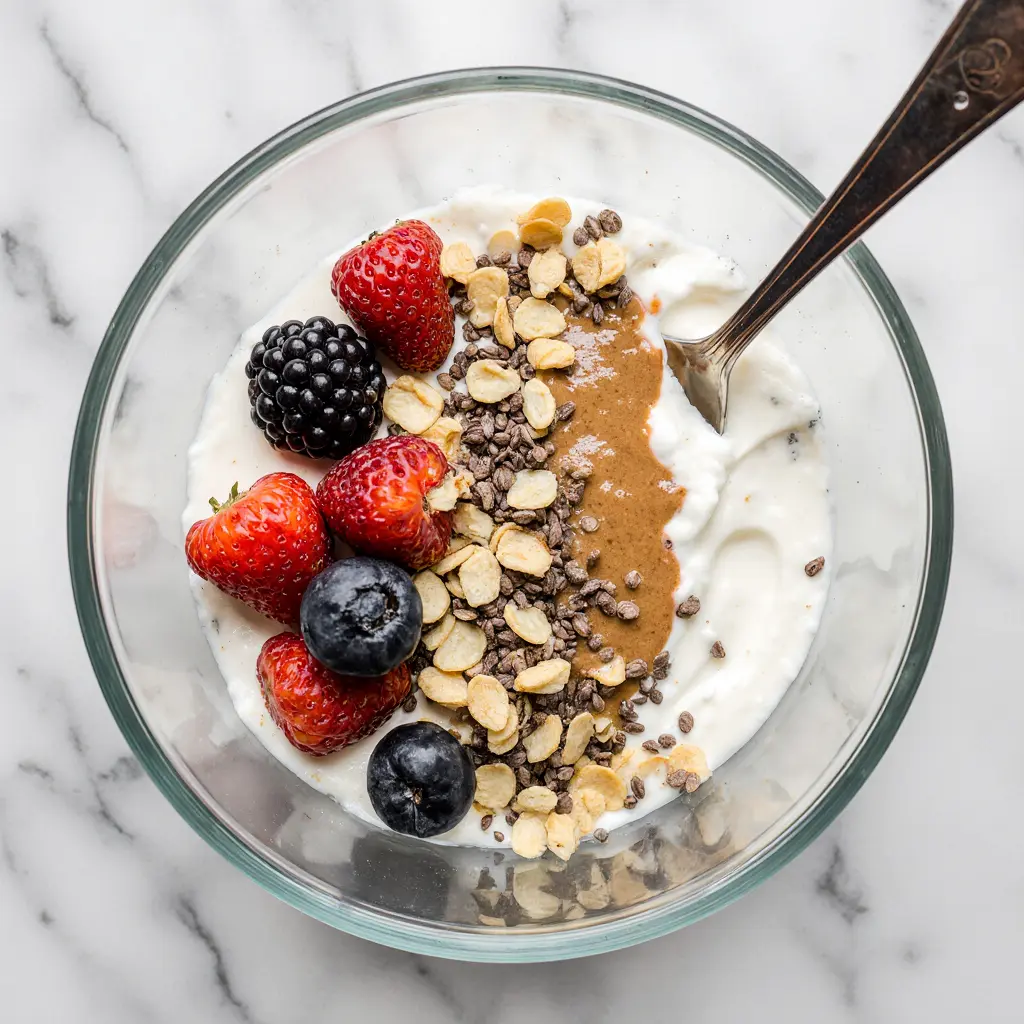If you’re trying to get more protein without the fuss of powders or meat-heavy meals, Greek yogurt might already be in your fridge. It’s one of those simple staples that packs a serious punch—but how much protein are you really getting per 100g? Whether you’re counting macros or just aiming for a more filling breakfast, knowing exactly what’s in your spoonful can make a difference.
In this article, we’ll walk through the real numbers behind Greek yogurt protein per 100g, how different brands and fat levels affect it, and smart ways to boost your intake. Plus, we’ll compare Greek and regular yogurt so you can pick what suits your goals best. Don’t forget to check our Greek yogurt and peanut butter nutrition guide for a creamy combo packed with protein and healthy fats.
Let’s break it down.
Protein Content in 100g of Greek Yogurt
How Much Protein Is In 100g of Greek Yogurt?
Greek yogurt is popular for a reason—it’s thicker, tangier, and richer in protein than regular yogurt. On average, 100g of plain nonfat Greek yogurt contains around 10g of protein. This makes it an easy, low-effort way to add protein to your day. That’s why it’s a favorite among fitness lovers, busy parents, and anyone trying to feel full longer without extra calories.
But that number isn’t set in stone. The exact amount of protein in 100g depends on the fat content, the straining method, and even the brand. Some full-fat versions contain slightly less, while certain high-protein brands pack even more per 100g.
Let’s break this down with real numbers.

Greek Yogurt Protein per 100g
Equipment
- Spoon
- bowl or container
- nutrition label (for checking protein)
Ingredients
- 100 g nonfat Greek yogurt (Chobani or similar)
- 100 g 2% Greek yogurt (Fage or similar)
- 100 g full-fat Greek yogurt
- 1 tbsp peanut butter (optional)
- 1 tbsp chia seeds (optional)
- 1 tbsp hemp hearts (optional)
Instructions
- Choose your Greek yogurt type based on fat level: nonfat, 2%, or full-fat. Check the label for exact protein per 100g.
- Compare nutrition labels from trusted brands like Chobani, Fage, Oikos, or Siggi’s to determine actual protein content.
- Boost your yogurt’s protein with mix-ins like peanut butter, chia seeds, or hemp hearts.
- Enjoy your yogurt plain or as part of a bowl, smoothie, or snack. Adjust your serving size and track macros if needed.
Notes
Table: Nutrition Facts of Greek Yogurt (per 100g)
| Type of Greek Yogurt | Protein (g) | Calories | Fat (g) | Carbs (g) |
|---|---|---|---|---|
| Nonfat Greek Yogurt | 10g | 59 | 0.4g | 3.6g |
| 2% Greek Yogurt | 9g | 73 | 1.9g | 3.9g |
| Full-Fat Greek Yogurt | 7–8g | 97 | 5g | 3.8g |
No matter the fat level, Greek yogurt still outshines regular yogurt when it comes to protein density. It’s strained more thoroughly, removing excess water and concentrating nutrients. And that’s also what gives it its signature thick texture.
If you’re looking for ways to keep Greek yogurt exciting, check out these high-protein cottage cheese ice cream recipes—they’re a great way to enjoy dessert without losing the benefits.

Factors Affecting Protein Content
Fat Level Impacts the Protein Amount
Not all Greek yogurt is created equal, especially when it comes to fat content. One of the most noticeable differences in greek yogurt protein per 100g is whether it’s nonfat, low-fat (like 2%), or full-fat. Fat doesn’t just change the calorie count—it can actually affect how much protein you get in every spoonful.
Nonfat Greek yogurt typically contains the most protein per 100g, often around 10g. That’s because when fat is removed, there’s more room for protein-dense solids. In contrast, full-fat versions often hover around 7–8g of protein per 100g. While they offer a creamier mouthfeel and added satiety, they’re not as protein-packed gram-for-gram.
Some people believe that full-fat yogurt is more “natural,” and in some cases it may be easier on digestion. But if your goal is simply protein intake per calorie, nonfat wins.
Brand & Straining Method Make a Difference
Another major factor? The brand—and how they strain their yogurt. Greek yogurt is strained to remove whey and liquid, which concentrates the protein. However, some brands strain more aggressively than others, and this shows in the nutrition label.
For example:
- Chobani Nonfat Plain Greek Yogurt offers around 10g protein per 100g
- Fage Total 0% ranges closer to 9.2g per 100g
- Store-brand full-fat options can fall to as low as 6.5g per 100g
Some brands also add extra milk protein to boost the content, making them ideal for high-protein diets. If maximizing your daily protein is key, it pays to check the back of the tub—especially if you’re following a plan like our smoothie weight loss diet where macros are closely tracked.
A related point: the fewer the additives, the better. Some flavored Greek yogurts come with thickeners, gums, or sugar, which lower the overall protein density. That’s why going for plain, unsweetened versions is not only cleaner—it’s also higher in real protein.
If you’re already soaking chia seeds in yogurt, you might want to read our guide on how chia and yogurt combine for satiety to get the most out of this combo.
Greek vs. Regular Yogurt Protein
Is Greek Yogurt Really Higher in Protein Than Regular Yogurt?
Yes—and by quite a bit. When comparing greek yogurt protein per 100g to regular yogurt, the difference is clear. Greek yogurt is strained more than traditional yogurt, removing much of the water and whey. What’s left is a thicker, creamier, and more concentrated product—with more protein in every bite.
Here’s what happens during straining: one cup of milk can yield about 100g of regular yogurt, but it takes nearly three times that much milk to make 100g of Greek yogurt. That’s why Greek yogurt naturally contains about two to three times more protein than regular yogurt of the same serving size.
Let’s break that down in a simple comparison.
Table: Greek vs. Regular Yogurt (Per 100g)
| Type | Protein (g) | Calories | Texture |
|---|---|---|---|
| Greek Yogurt (Nonfat) | 10g | 59 | Thick and creamy |
| Regular Yogurt (Low-fat) | 3.5–4g | 61 | Thin and smooth |
When Should You Choose Regular Yogurt?
Greek yogurt wins on protein, hands down. But regular yogurt still has its place. It tends to have more calcium, slightly more natural sugar (lactose), and a smoother taste, which some people prefer. If you’re making smoothies or creamy sauces, regular yogurt might blend more easily.
However, if you’re looking to feel full longer or need a low-calorie protein boost, Greek yogurt is the better choice. It works especially well for people following calorie-conscious meal plans or muscle-building diets.
If you’re craving a high-protein treat, you might want to experiment with keto ice cream sandwiches, where Greek yogurt can be a surprise star in low-carb frozen recipes.
Best High-Protein Greek Yogurt Brands
Top Brands with the Most Protein Per 100g
When you’re tracking greek yogurt protein per 100g, not all brands deliver the same punch. While plain Greek yogurt is typically high in protein, some brands go the extra mile by adding milk protein concentrates or using triple-straining techniques.
Here are some standout options that deliver the highest protein per 100g:
- Chobani Nonfat Plain Greek Yogurt – 10.2g protein
- Fage Total 0% – 9.2g protein
- Oikos Triple Zero – 10g protein (with zero added sugar)
- Siggi’s Icelandic Skyr – technically not Greek but ultra-high protein, about 11g per 100g
- Two Good – 9.5g protein, with only 2g of sugar
Most of these brands stay below 65 calories per 100g and are unsweetened. You can find them at nearly any major grocery store, and they all work well in savory bowls, smoothies, or on-the-go snacks.

For a delicious way to add flavor without the sugar, try stirring in some peanut butter with your Greek yogurt. This combo not only bumps up the protein but also gives it a creamy, indulgent taste that’s ideal post-workout or as an afternoon pick-me-up.
What to Look for on the Label
When comparing yogurt options, don’t just look at the front of the package. Turn it around and check:
- Protein per 100g (or per serving)
- Added sugars
- Live active cultures
- Thickening agents (like gelatin or starches)
Some “Greek-style” yogurts are thickened artificially and may have less protein than traditionally strained versions. If you’re also focused on gut health or meal planning, brands that list live probiotics like Lactobacillus or Bifidobacterium are worth choosing.
You might even combine Greek yogurt with superfoods or breakfast smoothies, like our refreshing lemon ginger spinach smoothie for a powerful protein-and-antioxidant start to the day.
Boosting Protein in Greek Yogurt
Simple Add-ins That Add Big Protein
Greek yogurt is already protein-rich, but you can turn it into a full-on protein powerhouse with the right mix-ins. This is especially helpful if you’re using it as a meal replacement or post-workout snack.
Here are some of the easiest ways to increase greek yogurt protein per 100g—without relying on processed powders:
- Peanut Butter: Just one tablespoon adds 4g of protein. Choose unsweetened, natural varieties to avoid added sugars. You’ll also get healthy fats for extra fullness.
- Chia Seeds: Each tablespoon packs 2g of protein along with fiber and omega-3s. Stir them in and let your yogurt sit for 5–10 minutes—they’ll thicken it up beautifully.
- Hemp Hearts: Mild in flavor, hemp seeds provide around 3g of protein per tablespoon and blend in easily.
- Unsweetened Protein Powders: A half scoop of whey or plant-based protein mixes well into yogurt and can add 10–12g of extra protein, depending on the brand.
We tested this combo in our natural ozempic drinks for satiety and weight management—and Greek yogurt consistently improved the nutrient density without raising blood sugar.

Creative Ways to Enjoy a Protein Boost
Want to enjoy your upgraded yogurt without the bland taste? Mix in flavors and textures that still align with your health goals:
- Berries: Low in sugar and rich in fiber, they add sweetness without the crash.
- Cocoa Powder + Almond Butter: A chocolatey mix that turns your yogurt into dessert—without losing the health benefits.
- Crushed Nuts or Low-Carb Granola: Great for crunch and added protein.
If you’re experimenting with sweet treats, try it in our 2-ingredient cottage cheese ice cream as a creamy frozen base. You’ll love the texture and the protein content.
For those tracking macros, here’s a tip: always calculate protein per 100g after adding mix-ins. This keeps your meals consistent and helps with meal prep goals.
FAQs About Greek Yogurt Protein Per 100g
How much protein is in 100g of plain Greek yogurt?
Plain Greek yogurt typically contains between 9g and 10g of protein per 100g. Nonfat versions usually have the highest amount, while full-fat varieties range closer to 7–8g depending on the brand.
Which Greek yogurt has the most protein per 100g?
Brands like Chobani Nonfat, Oikos Triple Zero, and Siggi’s Skyr top the list. Some offer up to 11g of protein per 100g, especially when they include milk protein concentrates.
Is Greek yogurt better than regular yogurt for protein?
Yes. On average, Greek yogurt has 2 to 3 times more protein per 100g than regular yogurt. The straining process removes more whey and water, concentrating the protein content.
How can I increase the protein content of my Greek yogurt?
Stir in peanut butter, chia seeds, hemp hearts, or a scoop of protein powder. These additions can bring your protein count well above 15g per 100g, depending on your mix-ins. Try it with our coconut cloud coffee for a high-protein breakfast combo.
Conclusion: Making the Most of Every Spoonful
Greek yogurt is more than a creamy snack—it’s one of the easiest, most versatile ways to pack quality protein into your diet. Whether you’re counting macros, managing weight, or just trying to stay full between meals, knowing exactly how much greek yogurt protein per 100g you’re getting makes all the difference.
From comparing brands to learning how fat levels affect protein, and even how to boost it with ingredients like chia and peanut butter, you now have the tools to make your yogurt work harder for you.
Whether you’re building a breakfast bowl, stirring it into smoothies, or freezing it into healthy treats, Greek yogurt proves you don’t need complicated meals to get serious nutrition.






5 thoughts on “Greek Yogurt Protein Per 100g: How Much You’re Really Getting”